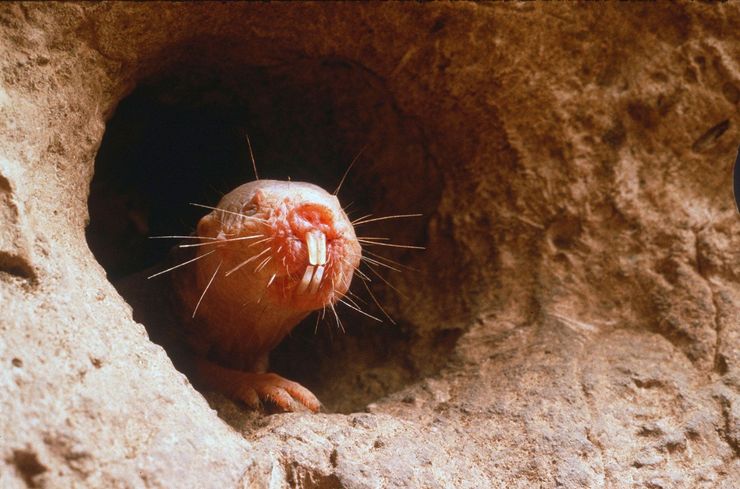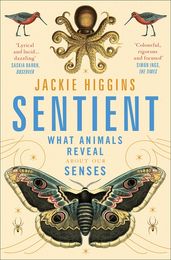The animals that unlock unimaginable worlds within our own
Colour blind cuttlefish that use a secret language of light, fish that walk on fins that can taste, and butterflies that can sense the earth's magnetic field . . . Jackie Higgins introduces us to the remarkable creatures whose extraordinary senses can unlock new worlds within our own.

Jackie Higgins, author of Sentient, takes us on a trip through the senses of wild creatures, from the eight-eyed ogre-faced spider to the serenading concave-eared torrent frog to infra-red aware vipers. As Higgins demonstrates, animals perceive the world in multiple and marvellous ways . . .
The first challenge I faced when writing Sentient was to select a cast of creatures to represent our different human senses. The entire animal kingdom was at my disposal: the one million or so known species along with the thousands of new ones discovered every year. My task appeared Herculean. To narrow the field, I began a deep trawl through academic literature, in search of those creatures whose sensory systems had attracted scientific scrutiny and could shed light on our own capabilities.
We assume that what we sense represents the limits of the world. Take what we see: we rely overwhelmingly on our colour vision. We may revel in the spectacular rainbow displays of a male peacock’s plumage or an Australian giant cuttlefish’s shade-shifting mantle, forgetful of the fact that our eyes detect only a slither of the available electromagnetic spectrum. The amount of information within light is diverse, possibly infinite. Birds see wavelengths that are invisible to our eyes, so do bees and butterflies; to them, peacock feathers quiver in multi-coloured and ultraviolet hues. The cuttlefish might be colour blind in the traditional sense but it can still distinguish between the many shades of the rainbow. Furthermore, because this creature is sensitive to the way in which light is polarised, it accesses an entirely new visual dimension: a secret language of light.
‘Birds see wavelengths that are invisible to our eyes, so do bees and butterflies; to them, peacock feathers quiver in multi-coloured and ultraviolet hues.’
The ogre-faced spider demonstrates another skill. It can eke out photons, even on nights without moon or stars. Suspended in vegetation, it stretches a sticky, silken net between its front legs. Two of its eight eyes are so enormous – the largest of any arachnid – they can make out tiny movements in the gloom. This enables the spider to lunge with ballistic speed and precision, to ensnare its next meal.

The pit viper’s ability to strike at mice in the pitch dark is widely attributed to infra-red ‘vision,’ but in actuality this sense is an unusual form of touch that takes place without any physical contact. Today, ‘touch’ is an umbrella term for many separate somatic senses. ‘Discriminative touch’ describes how our fingertips discern the corrugated roughness of a walnut or the smoothness of a ball bearing, or how a boa constrictor knows when to relax its deadly embrace, feeling its victim’s fading pulse.
In contrast, the viper uses a sense of touch called ‘thermoception’ to register the infra-red aura radiating from its warm-blooded prey. Recently, scientists found that the heat-sensing molecules in the snake’s pit organs are much like ones that are present in our skin. These enable us to experience the warmth of human contact; those of the snake are so sensitive, they detect the heat of a mouse up to one metre away.
There is a further variant of touch. The naked mole rat may survive without oxygen for some eighteen minutes, resist aging and cancer, but most notably it is impervious to certain types of pain. As humans, we smart when our skin is rubbed with chilli or acid, but this buck-toothed, boss-eyed rodent feels nothing. Pain serves a clear purpose, warning of often invisible dangers; it is our guardian angel. Scientists are undecided as to why this sense is diminished in the naked mole rat. Perhaps it is because the atmosphere in their burrows is so acrid. Or, because they share their home with an aggressive and venomous species of ant. Either way, this creature provides inspiration and clues that may well lead to a remedy for human pain.

What is true of vision and touch also applies across our other senses. The natural world is clamorous with sounds that we cannot hear because our ears detect only a narrow band of frequencies. We are deaf to the low infrasound of elephants communicating across the African plains and to the infrasonic rumbles within a tiger’s roar. On a balmy summer evening, we are oblivious to an ultrasonic battle taking place above our heads. Bats deploy high-frequency sonar to chase tiger moths on the wing, but their system can be jammed, either by a competitor swooping in to steal the prize or by the insect retaliating to defend itself.
The echolocation of the greater bulldog bat is so precise that, as it skims over a pond, it can detect the tell-tale ripple of a fish beneath the surface from thirteen metres away. Yet none of these auditory experts can compete with one unusual Chinese amphibian. The concave-eared torrent frog gathers at the foot of thunderous waterfalls. To serenade potential mates through the din, it issues ultrasonic notes. However, its audience is not always tuned to these seductive frequencies. In much the same way as we dial into a radio station, this tiny frog adjusts its audible bandwidth. It is the only known species to select what it can hear.
‘In much the same way as we dial into a radio station, this tiny frog adjusts its audible bandwidth. It is the only known species to select what it can hear.’
The animal kingdom is suffused with odours: some alluring, some odious, others we cannot smell, yet which may still sway us subliminally. Not all noses are created equal. A polar bear can pick up the scent of a seal’s breathing hole from some three kilometres. On moonless nights, an Asian ailanthus silkmoth raises its antennae to the air currents and uses the same sense to find a female five kilometres away. Much as noses are not necessary for smell, nor are tongues for taste. Blowflies taste through their feet and a fish called the sea-robin does so through its fins. Meanwhile, a snake flicks its forked tongue to sample scents on the air. To blur divisions further between the organs of taste and smell, scientists have found that our tongue can detect odours and our nose is scattered with taste-like cells.

Nature boasts sensory powers that extend far beyond the obvious. Monarch butterflies can sense the earth’s magnetic field, enabling them to navigate an annual pilgrimage from Canada to Mexico, and back again. Rufous hummingbirds can sense the time of day. When a great white shark attacks, it rolls back its eyeballs and relies on its ability to sense the electric field of its victim.

The Skywalker hoolock gibbon, only discovered in 2017, leaps and swings through the towering trees of the Gaoligong Forest, saved from falls by sharpened senses of body, movement and balance. As the naturalist E. O. Wilson asserts, biologically speaking, earth remains ‘a mostly unexplored planet.’ Despite my training as a zoologist, followed by decades making natural history and science documentaries, I was mesmerised by the abundance of biodiversity that I encountered when researching this book. The truth is, I was spoilt for choice. Sentient showcases a whole different cast of creatures whose senses reveal the many worlds within our own.
Sentient
by Jackie Higgins
Sentient assembles a menagerie of zoological creatures – from land, air, sea and all four corners of the globe – to understand what it means to be human. Through their eyes, ears, skins, tongues and noses, the furred, finned and feathered reveal how we sense and make sense of the world, as well as the untold scientific revolution stirring in the field of human perception.
References
C. Mora et al. ‘How Many Species Are There on Earth and in the Ocean?’ Public Library of Science Biology, 2011, 9 (8), e100112
A. L. Stubbs & C. L. Stubbs, ‘Spectral discrimination in color blind animals via chromatic aberration and pupil shape’, Proceedings of National Academy of Sciences, 2016, 113 (29), 8206-8211, and, S. E. Temple et al., ‘High resolution polarisation in a cuttlefish’, Current Biology, 2012, 22 (4), R121-R122
J. A. Stafstrom & E. A. Hebets, ‘Nocturnal foraging enhanced by enlarged secondary eyes in a net-casting spider’, Biology Letters, 2016, 12, 20160152
E. A. Newman & P. A. Hartline, ‘The infrared “vision” of snakes’, Scientific American, 1982, 246, 116–127; S. M. Boback et al., ‘Snake modulates constriction in response to prey’s heartbeat’, Biology Letters, 2012, 8, 473-476, and E. O. Gracheva et al., ‘Molecular basis of infrared detection by snakes’, Nature, 2011, 464, 1006–1011
O. Eigenbrod et al., ‘Rapid molecular evolution of pain insensitivity in multiple African rodents’, Science, 2019, 364 (6443), 852-859
A. J. Corcoran & W. E. Conner, ‘Bats jamming bats: Food competition through sonar interference’, Science, 2014, 346 (6210), 745-747; A. J. Corcoran et al., ‘Tiger moth jams bat sonar’, Science, 2009, 325 (5938), 325-327 and K. Ubernickel et al., ‘Sensory challenges for trawling bats: Finding transient prey on water surfaces’, The Journal of the Acoustical Society of America, 2016, 139, 1914-1922
M. Gridi-Papp et al., ‘Active control of ultrasonic hearing in frogs’, Proceedings of National Academy of Sciences, 2008, 105 (31), 11014-11919
M. Novak, Wild furbearer management and conservation in North America, ed. M. Novak et al., Ontario Trappers Association, 1987, 474–485
P. Rau & N. L. Rau, ‘The sex attraction and rhythmic periodicity in giant saturniid moths’, Transactions of the Academy of Science St Louis, 1929, 26, 83-221
B. Malik et al., ‘Mammalian taste cells express functional olfactory receptors’, Chemical Senses, 2019, 20, 1–13 and T. E. Finger, ‘Solitary chemoreceptor cells in the nasal cavity serve as sentinels of respiration,’ Proceedings of the National Academy of Sciences, 2003, 100, 8981–8986
P. Fan et al., ‘Description of a new species of Hoolock gibbon (Primates: Hylobatidae) based on integrative taxonomy’, American Journal of Primatology, 2017, 79 (5), e22631
E. O. Wilson, Diversity of Life, Harvard University Press, 1992



